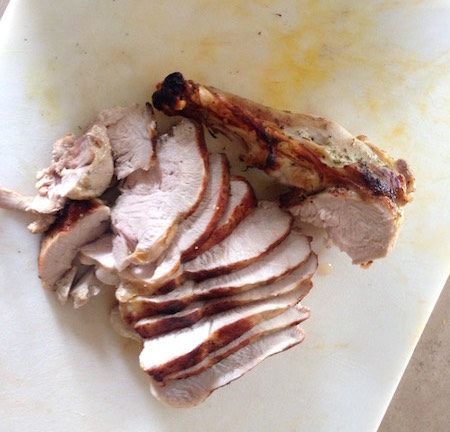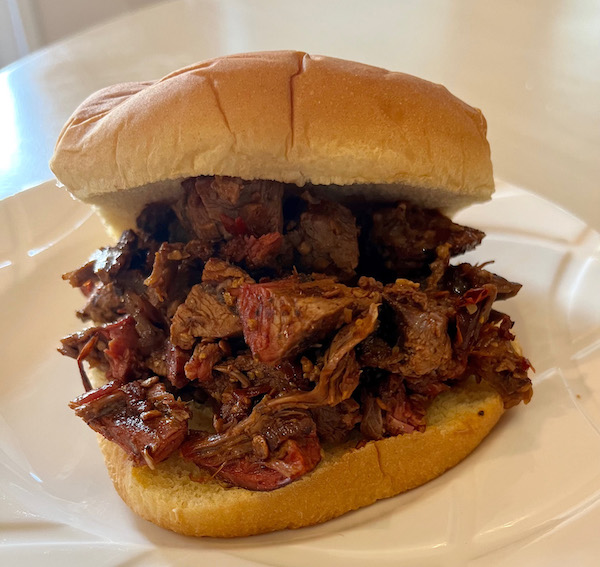It is not a big patch of ground, but it is my patch…kind of. You see, I am willing to walk longer, crawl farther and basically put up with a bunch of access BS to get to the land. My tenacity gets me something special: un-hunted turkeys. An awesome find that only two others know about, and I’ll keep it that way.
It’s these birds I return to each spring — two per year, no more. They fill my larder and heart. They are a hold-over meat until the fall season opens. My freezer tends to be getting dry by August. By the time I break into the turkeys, my usual red meat is all but gone. I hold the breast for special occasions: family meetings, dinner parties, or when the wife heads to Vegas for a girls’ weekend.
With wild turkey it is best to employ a brine before cooking it. (Brine is just salt water and seasonings you soak the meat in, no big deal.)
After brining the meat for a day, I fold the thin section of breast meat under itself and skewer it all together. The goal in doing this is to create one, somewhat uniform, piece of meat. If the breast was cooked “as is” it would be very dry on the thin end, while the thick end remained raw.
As fall draws closer each day, I find myself running more, shooting my bow more, and looking to my patch of ground. With finding and cooking wild game, I am willing to go the extra step — to find the good grounds. I am willing to do the little extra things that make for a better meal and adventure. But unlike my hunting spot, I’ll tell everyone about the food.
The Brine
Science time! A brine functions in two ways. First, the brine–specifically the salt–partially dissolves the muscle filaments. With fewer filaments, the flesh is not able to constrict as much when cooked, making the meat more tender. Secondly, the interaction of salt and protein allows the meat to hold up to 10% more moisture. When cooking a turkey, you lose about 20% of the moisture during the cooking process anyway. So with a brine you effectively lose only half the water you would otherwise. Basically, brining equals more tender and juicy meat.
This recipe is enough for one wild turkey breast; if you have two, double the recipe.
- 1 quart warm water
- 2 tablespoons Kosher salt
- 1 orange, cut into four “”rounds””
- ½ teaspoon black pepper
- 1 teaspoon dried thyme
- 2 cloves garlic, crushed
- 1 bay leaf
In a mixing bowl, combine the warm water and salt, making sure to stir and incorporate it all. You should not see any flakes of salt on the bottom of the bowl. Next, add the remaining ingredients and stir. Put the wild turkey breast into the bowl, completely submerging the meat in the brine. Cover with plastic wrap and refrigerate for at least 24 hours, 48 preferably.
Cooking the Breast
Remember, the breast should be skewered together to create an even thickness on the breast.
- 1 wild turkey breast
- Salt
- Pepper
- 1 tablespoon oil
- 1 orange, from brine
Remove the breast from the brine and pat it dry with paper towels. Season the outside with salt and pepper. Let stand for 20 minutes to reach room temperature. Turn the oven to broil.
Heat a 12-inch cast iron or other thick-bottomed skillet over medium heat for five minutes. The pan needs to be oven safe.
Add oil to the pan. Carefully add the breast, “”skin”” side down (or the side the skin would have been on). This will cause oil to sputter and splat all over the place. Cover the pan with a lid, cracked to allow moisture out. Let the breast sear until GB&D (golden brown and delicious). This will take 4-5 minutes.
Flip the breast over. Place the orange slices on top of the browned meat and transfer the pan, with the turkey inside it, into the oven. Place the pan on the middle rack and broil until the internal temperature reaches 145 degrees; about 10-15 minutes depending on the size of the bird you shot. A thermometer is invaluable at this point.
 When the turkey reaches 145°, remove it from oven and let stand for 5 minutes before cutting into it, otherwise all the juices will be on the cutting board, not in the bird. Slice thin (see photo) and serve with your favorite sides.
When the turkey reaches 145°, remove it from oven and let stand for 5 minutes before cutting into it, otherwise all the juices will be on the cutting board, not in the bird. Slice thin (see photo) and serve with your favorite sides.
”







Leave A Comment